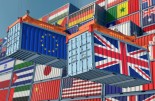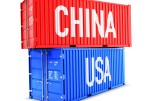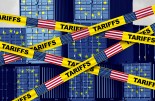Is the trade deficit of the US with the EU really that bad?

President Trump has signed numerous executive orders via which import tariffs have been imposed on its main trading partners. So far, Europe is spared except the tariffs on steel and aluminium. It is however likely that tariffs on a wider set of goods will be implemented.
By Tim Sterk, Portfolio Manager Multi Asset Investment Group at Aegon Asset Management
In Trump’s eyes it is unfair that Europe is exporting more to the US than vice versa. He backs up this conviction with the structural trade deficit of the US with Europe.
However, we argue the current account is actually in balance, and the EU might even have a deficit when accounting for profit shifting. Regardless, the current course of action is likely to result in a lose-lose situation for both economies. An analysis by Aegon Asset Management.
The US trade balance in historical perspective
The US trade balance measures the difference between the value of goods and services which are exported from and those imported to the US. When this difference is negative, a country’s imports are higher than its exports, resulting in a trade deficit.
The trade balance of the US has been in deficit with the rest of the world for almost half a century. The last time it ran a trade surplus was in 1975. The current trade deficit relative to the US GDP is lower than its historical average of 3.5% since 2000.
Why the persistent US trade deficit?
The existence of the systematic trade deficit of the US over the past half century can be explained by numerous factors.
The first is linked to behavioral and cultural traits. There is an observable difference between US and European actors when it comes to saving and spending. This difference relates to factors such as culture, demographics, the regulatory frameworks and taxation.
German and Dutch consumers and businesses for instance tend to have high savings rates and are critical on large government deficits. In the US on the other hand, the consumer savings rate is lower, and the government runs a higher deficit, especially in the last couple of years.
A second explanation is considering the unique position of the US dollar as the de facto global reserve currency. Central banks, corporates, and governments around the world hold US dollar assets to manage exchange reserves and to settle trade flows. A persistent US trade deficit should cause the dollar to depreciate as the US would continuously need to attract capital to fund the deficit. A depreciating currency should help to improve the trade balance as US products would become more affordable for foreigners on the back of the weaker dollar.
Negative trade balance, but balanced current account
The White House is vocal about its trade deficit with the EU. However, the current account actually doesn’t have a deficit and is in balance between the two blocs.
The current account not only measures the flow of goods and services, but also incorporates interest payments, dividends and transfers between countries. It is therefore a broader and more accurate measure of the economic relationship.
Figure 1: Current Account balance of Europe with the US

Source: European Central Bank, Aegon Asset Management (as of Mar-2025)
Looking at the current account, the EU indeed has a deficit in goods. The EU is exporting a diverse range of goods but is especially strong in industrial machinery and pharmaceuticals. The US has however a surplus in services. Especially, financial services are a large part of this balance. The US financial institutions clearly have strong market positions in the EU market.
Another significant part of the current account balance are interest and dividends, which is captured in the primary income balance. As seen from the chart, this balance is negative for Europe. Clearly US companies, and particularly the tech companies, control large parts of the European IT landscape. This results in a significant primary income deficit with the US.
Overall, the economic relation, again only looking at the current account, is therefore much more in balance than only the goods deficit would suggest.
Profit shifting might actually imply a deficit
In fact, the Current Account balance might be even overestimated.
Especially statistics on primary income are difficult to track due to the complex flow of income through corporate structures and varying ownership of these corporates. However, there are indications that corporate profit shifting could significantly distort the data in such a way that the US actually has a current account surplus.
Multinational enterprises attempt to shift their profits from high-tax regions to low-tax regions. These profit-shifting practices inflate the current account statistics of low tax counties. Recognizing the fact that major US companies’ earnings are many hundreds of billions of dollars per year, the impact on the current Account can be substantial.
Tariffs and retaliatory tariffs: a costly game?
The US is likely to introduce significant tariffs on EU goods. In response, the EU will likely introduce retaliatory tariffs.
The White House mostly stresses the, in their eyes, unfair trade deficit which the US has with the rest of the world, the EU included. Tariffs, they argue, are an adequate tool to improve this trade imbalance between the US and the EU.
Also, the desire of the EU to become less dependent on the US for defense, technology and energy, will imply higher costs.
The resulting equilibrium is hence one in which a set of mutual tariffs is in place between the US and the EU. This situation resembles that of the typical 'prisoner’s dilemma': by going for individual gain both parties will lose. The outcome is therefore worse for companies, consumers and both economies than a trade relationship with open borders.
Avoiding this stalemate would require a different course of action than starting a trade war: a situation in which both the EU and the US would recognize the mutual benefits of open trade borders.
Tim Sterk
Tim Sterk, CFA, FRM, is a Portfolio Manager in the Multi-Asset Group responsible for managing the firm’s asset allocation fund range and our alternative risk premia strategy. Prior to joining the firm, he worked for almost four years at NIBC Bank as a Mortgage Portfolio Manager. Sterk has been in the industry since 2012 and joined the firm in 2015. He holds a Master’s degree in Quantitative Finance from Erasmus University Rotterdam. He is a CFA charterholder and completed training as Financial Risk Manager (FRM).









